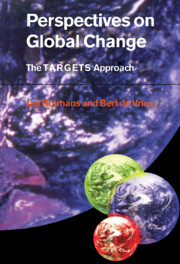Book contents
- Frontmatter
- Contents
- Foreword
- Preface
- 1 Global change and sustainable development
- Part One The TARGETS model
- 2 Concepts
- 3 The TARGETS model
- 4 The Population and Health submodel
- 5 The energy submodel: TIME
- 6 The water submodel: AQUA
- 7 The land and food submodel: TERRA
- 8 The biogeochemical submodel: CYCLES
- 9 Indicators for sustainable development
- 10 Uncertainties in perspective
- Part Two Exploring images of the future
- References
- Acronyms, units and chemical symbols
- Index
3 - The TARGETS model
from Part One - The TARGETS model
Published online by Cambridge University Press: 06 July 2010
- Frontmatter
- Contents
- Foreword
- Preface
- 1 Global change and sustainable development
- Part One The TARGETS model
- 2 Concepts
- 3 The TARGETS model
- 4 The Population and Health submodel
- 5 The energy submodel: TIME
- 6 The water submodel: AQUA
- 7 The land and food submodel: TERRA
- 8 The biogeochemical submodel: CYCLES
- 9 Indicators for sustainable development
- 10 Uncertainties in perspective
- Part Two Exploring images of the future
- References
- Acronyms, units and chemical symbols
- Index
Summary
When tackling a subject as complex as global change and sustainable development, it is essential to be able to ‘frame the issues’. This was one of the main reasons for developing the TARGETS model, an integrated model of the global system, consisting of metamodels of important subsystems. In this chapter we introduce TARGETS. Building on the previous chapters, we elaborate on the possibilities and limitations of integrated assessment models. Some of the key issues discussed are aggregation, model calibration and validation, and dealing with uncertainty.
Introduction
One of the main tools used in integrated assessment of global change issues is the Integrated Assessment (IA) model. This chapter introduces such an integrated model, TARGETS, which builds upon the systems approach and related concepts introduced in Chapter 2. Previous integrated modelling attempts either focused on specific aspects of global change, for instance the climate system (IPCC, 1995), or consisted merely of conceptual descriptions (Shaw et al., 1992). We have tried to go one step further, linking a series of cause-effect chains of global change. Although we realise the shortcomings in our current version of the TARGETS model, we felt there was a need to present our model to a wide audience. We first give some advantages and limitations of IA models. Next, we discuss issues of aggregation, calibration, validation and uncertainty. We proceed with a brief description of the five TARGETS submodels which coincides with the PSIR concept and the vertical integration as introduced in Chapter 2. A more detailed description of these submodels is given in Chapters 4 to 8.
- Type
- Chapter
- Information
- Perspectives on Global ChangeThe TARGETS Approach, pp. 33 - 54Publisher: Cambridge University PressPrint publication year: 1997

